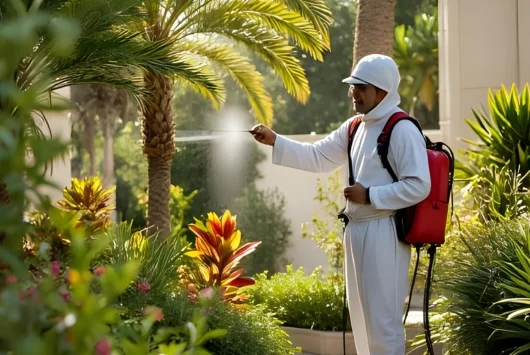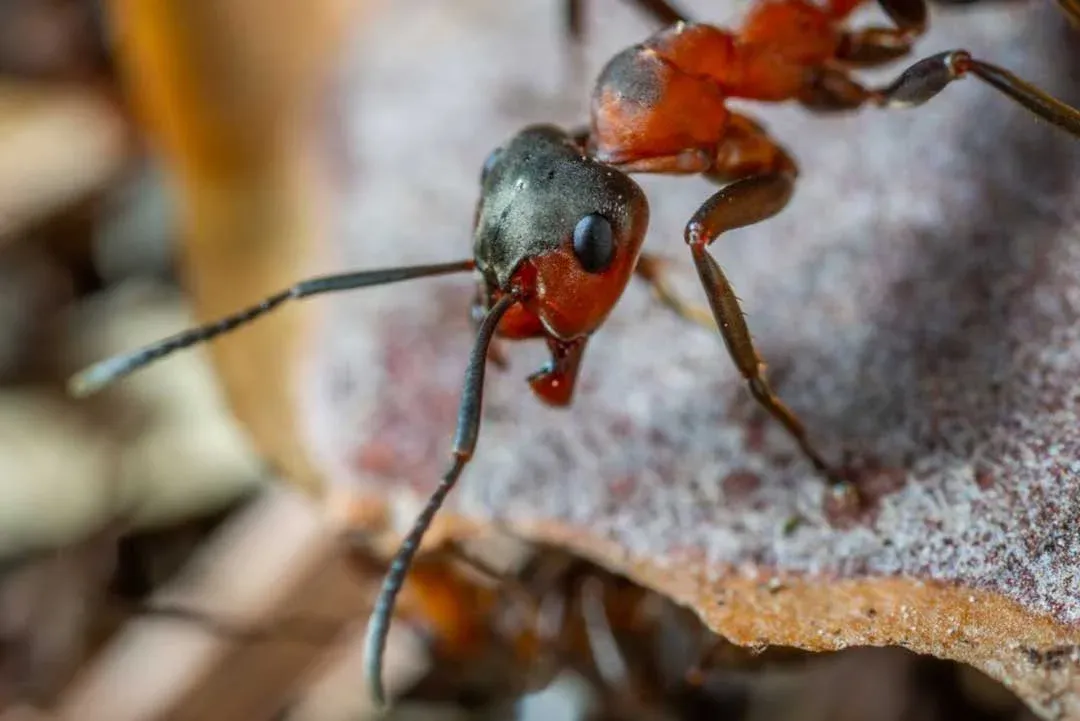- Tulip Al Barsha, Office G02, Barsha Rd, Al Barsha 1, Dubai – United Arab Emirates
- +971 56 369 0115
Ants invading your kitchen, pantry, or outdoor spaces? At UAE Pest Control, we provide fast, effective ant removal solutions designed to eliminate entire colonies, not just the ants you see. With same-day service across Dubai, Ajman, and Sharjah, our experts use advanced techniques to protect your property from persistent ant infestations.
✓ Safe for families & pets
✓ Complete colony elimination
✓ Years of proven expertise
Don’t let ants contaminate your food and spaces—book your ant removal service today!
Dubai’s warm climate and urban environment create ideal conditions for numerous ant species to thrive year-round. Unlike temperate regions where ant activity slows during winter, UAE properties face constant ant pressure with temperatures rarely dropping below comfortable levels for these persistent insects. The combination of abundant food sources in residential and commercial kitchens, construction materials providing nesting sites, and landscaping offering outdoor colonies makes ant control particularly challenging.
Common Entry Points: Ants can exploit cracks as thin as 1mm, entering through foundation gaps, utility line openings, window frames, and door thresholds. A single colony can house thousands to hundreds of thousands of workers, meaning the few ants you see represent a fraction of the actual infestation.
Modern Dubai buildings, while architecturally impressive, often feature design elements that inadvertently support ant populations. False ceilings create hidden highways for ant movement, electrical conduits provide protected routes between floors, and HVAC systems with condensation issues offer both water sources and nesting locations. Villa gardens with irrigation systems, mulched beds, and outdoor kitchens become prime real estate for multiple ant colonies.
The challenge intensifies in Dubai’s luxury developments where pristine aesthetics meet practical pest pressures. Residents expect immaculate homes free from crawling insects, yet traditional construction methods, landscaping requirements, and lifestyle factors continuously attract ants. Commercial establishments face additional scrutiny—restaurants require health department compliance, hotels maintain reputation standards, and retail spaces cannot afford customer complaints about ant contamination.
Food safety concerns make ant control essential beyond mere nuisance factors. Ants contaminate food products through direct contact and waste deposition, creating health code violations in commercial kitchens and food storage areas. Certain species bite or sting, posing risks to children, pets, and sensitive individuals. Property damage occurs when carpenter ants excavate wood structures or when colonies nest within electrical equipment, potentially causing shorts and equipment failure.
Our specialist team delivers customized ant control services addressing Dubai’s specific ant species and property challenges. We combine scientific understanding of ant behavior with proven treatment methods for complete colony elimination and long-term protection.
Kitchen and Pantry Treatment: Targeted interior applications eliminating foraging ants while tracking them back to source colonies. We treat entry points, trailing routes, and nesting areas using family-safe products that don’t contaminate food preparation surfaces.
Villa Garden Management: Comprehensive outdoor treatments addressing landscape colonies, irrigation system nesting sites, and perimeter barriers preventing outdoor colonies from entering homes. Special attention to garden beds, paving joints, and outdoor entertainment areas.
Apartment Building Service: High-rise solutions addressing unique challenges of shared walls, common plumbing, and vertical ant movement through utility chases. Coordinated building-wide treatments provide superior results compared to single-unit approaches.
Balcony and Terrace Protection: Elevated outdoor space treatments eliminating ant colonies in planters, drainage systems, and structural joints common in Dubai apartment developments.


Restaurant and Cafes: Health code compliant treatments protecting dining areas, kitchens, and food storage spaces. We work around operational schedules using odorless, non-toxic formulations approved for food service environments.
Hotels and Hospitality: Discreet treatments maintaining guest comfort while eliminating ant problems in rooms, common areas, and food service operations. Regular maintenance programs prevent recurring issues that damage reputation.
Retail and Supermarkets: Comprehensive programs protecting merchandise, especially food products, from ant contamination. Focus on stockrooms, display areas, and employee break rooms where ant problems commonly develop.
Office Buildings: Business environment solutions addressing pantries, break rooms, and outdoor gathering spaces where food waste and beverage spills attract ant colonies.
Colony Elimination System: Advanced baiting strategies using delayed-action products that workers carry back to colonies, eliminating queens and entire populations at the source rather than just visible workers.
Perimeter Defense Installation: Comprehensive barrier treatments creating protective zones around buildings, preventing outdoor colonies from establishing indoor satellite nests.
Construction Site Prevention: Pre-construction and during-construction treatments preventing ant colonization in new developments, protecting buildings before residents move in.
Integrated Management Plans: Long-term programs combining multiple control methods, structural modifications, sanitation improvements, and regular monitoring for sustainable ant prevention.

Dubai’s consistent warmth means ant activity continues year-round, though behavioral patterns shift with seasons. Summer months drive more ants indoors seeking air-conditioned comfort and reliable water sources. Indoor ant problems often intensify during June through September as outdoor colonies send foraging parties into cooler building interiors.
Cooler winter months from November through March trigger increased outdoor ant activity as comfortable temperatures allow expanded foraging ranges. This season also brings colony reproduction, with new queens attempting to establish satellite colonies that may target your property.
Rainfall, though infrequent in Dubai, significantly impacts ant behavior. Even light rain can flood ground colonies, forcing entire populations to relocate quickly. This emergency response often pushes ants into buildings as they seek dry nesting sites, causing sudden indoor infestation increases following weather events.
Pharaoh Ants represent one of Dubai’s most challenging indoor pests. These tiny yellow ants, barely 2mm long, establish massive colonies with multiple queens, making elimination difficult without professional expertise. They commonly infest hospitals, hotels, and apartment buildings, traveling through electrical systems and plumbing chases to spread throughout structures. Pharaoh ants contaminate sterile environments and food products, requiring specialized baiting protocols that avoid colony fragmentation.
Black Garden Ants dominate outdoor spaces throughout Dubai, building colonies under paving stones, in garden beds, and around building foundations. While primarily outdoor nesters, these ants readily enter buildings seeking food and water, creating trails across patios, through doorways, and into kitchens. Their large colony sizes and aggressive foraging behavior make them persistent nuisances.
Carpenter Ants pose structural risks when they establish colonies in wooden building components. Unlike termites, carpenter ants excavate wood for nesting rather than consuming it, but the damage can still compromise structural integrity. In Dubai’s construction, they target water-damaged wood, foam insulation, and hollow doors, creating galleries that weaken these materials.
Ghost Ants earn their name from pale legs and abdomens that make them appear to vanish against light surfaces. Common in humid areas like bathrooms and kitchens, these tiny ants nest in potted plants, behind wall tiles, and in cabinet voids. Their preference for sweet substances makes them frequent pantry invaders.
Crazy Ants move in erratic, rapid patterns that distinguish them from other species. They prefer protein-based foods and nest in various locations including soil, wall voids, and even electronics where their attraction to electrical equipment can cause shorts and equipment damage.
Effective ant control begins with thorough property evaluation by certified technicians trained in ant biology and behavior. Our inspectors identify ant species present, locate colony nesting sites, trace foraging trails to food and water sources, and assess structural conditions contributing to infestations.
We use specialized tools including moisture meters to detect water-damaged wood attracting carpenter ants, thermal imaging to locate colonies behind walls, and UV lights revealing ant trails invisible to naked eyes. This comprehensive assessment creates detailed treatment plans targeting specific ant species and nesting locations rather than applying generic treatments that often fail.
Documentation includes photography of active ant areas, identification of entry points requiring sealing, and recommendations for structural modifications preventing future infestations. Property maps show treatment zones, monitoring station locations, and high-risk areas requiring ongoing attention.
Targeted Baiting Systems: Scientific ant control relies heavily on baiting strategies using delayed-action products. Foraging ants consume bait and carry it back to colonies, sharing it through feeding behaviors that distribute active ingredients throughout the colony including queens, workers, and larvae. This approach eliminates entire colonies rather than just visible ants, providing complete control where sprays typically fail.
Bait formulations vary based on ant species preferences. Protein baits attract species like crazy ants and carpenter ants, while sugar-based baits target pharaoh ants and ghost ants. Our technicians select appropriate baits based on species identification and seasonal dietary preferences that shift between protein (colony growth periods) and carbohydrates (energy needs).
Residual Barrier Treatments: Long-lasting insecticide applications to surfaces where ants travel create protective barriers preventing colony expansion and building entry. We treat baseboards, window frames, door thresholds, pipe penetrations, and other strategic locations using products that remain effective for weeks or months.
Dust Applications: Specialized insecticidal dusts applied to wall voids, electrical outlets, and other hidden spaces eliminate ants in areas where liquid treatments and baits cannot reach. Dusts remain effective indefinitely when protected from moisture, providing long-term colony elimination.
Crack and Crevice Treatments: Precision applications targeting specific ant entry points and harborage areas minimize product usage while maximizing effectiveness. This focused approach suits sensitive environments requiring minimal chemical exposure.
Non-Repellent Technology: Advanced products that ants cannot detect allow them to contact treated surfaces and carry active ingredients back to colonies before the products take effect. This contrasts with traditional repellent insecticides that merely deflect ants to untreated areas without eliminating colonies.


Understanding family and environmental safety priorities, we offer comprehensive green ant control options using plant-based products, mechanical exclusion methods, and minimal-risk baiting systems. These approaches provide effective ant elimination while ensuring complete safety for children, pets, and beneficial insects.
Natural ant deterrents include diatomaceous earth, boric acid-based baits, and botanical repellents derived from essential oils. Physical exclusion through comprehensive sealing of entry points provides long-term prevention without chemical dependence.
Our integrated pest management approach emphasizes sanitation improvements, structural modifications, and behavioral changes that reduce ant attractants, decreasing reliance on chemical treatments while maintaining excellent control results.
All treatments meet strict UAE safety and efficacy standards, with full regulatory compliance and certified technicians ensuring professional service quality.
Our team understands complex ant biology, colony structures, and species-specific behaviors that determine treatment success. Continuous training keeps us current with latest control technologies and emerging ant management strategies.
Investment in professional-grade baiting systems, application equipment, and diagnostic tools delivers superior results unavailable through DIY approaches or general pest control services.
Complete warranty coverage with follow-up treatments included. If ants return within our guarantee period, we provide additional services at no charge until your property remains ant-free.
Urgent ant problems receive immediate attention with technicians available 24/7 for emergency response. Important events, health inspections, or severe infestations get priority scheduling.
Service in Arabic, English, Hindi, and Urdu ensures clear communication throughout the treatment process, with customer service teams understanding Dubai’s diverse community needs.
Ant prevention begins with eliminating food sources that attract foraging workers. Store all food in sealed containers including pet food, which represents a major ant attractant many homeowners overlook. Clean spills immediately, sweep floors daily, and manage garbage in sealed bins emptied regularly.
Kitchen maintenance includes wiping counters with vinegar solutions that eliminate ant pheromone trails, cleaning behind appliances where crumbs accumulate, and ensuring sink areas stay dry since water sources attract ants as much as food. Dishwashers, often loaded but not run immediately, can attract significant ant activity if food residue remains accessible.
Physical barriers provide the most permanent ant prevention. Seal cracks in foundations, walls, and around utility penetrations using appropriate caulking materials. Weather stripping around doors and windows eliminates common ant entry routes. Pay special attention to areas where different building materials meet, as these expansion joints often create ant-sized gaps.
Address moisture problems that attract ants and promote colony establishment. Fix leaking pipes, ensure proper drainage around foundations, repair water-damaged wood, and maintain gutters preventing water accumulation near buildings. In Dubai’s climate, air conditioning condensation represents a major ant attractant requiring proper drainage system maintenance.
Outdoor ant control starts with yard maintenance reducing colony establishment near buildings. Keep mulch, soil, and plant beds at least 30cm away from foundations. Trim vegetation touching buildings as these create bridges allowing ants easy building access. Remove landscape debris, stored wood, and unnecessary materials that provide nesting sites.
Irrigation management prevents overwatering that creates ideal conditions for ant colonies. Water in the morning allowing soil to dry, fix sprinkler heads spraying buildings, and address drainage issues creating standing water. Consider replacing water-intensive landscaping with drought-tolerant alternatives requiring less irrigation.
While ants don’t transmit diseases like mosquitoes or rodents, they pose significant contamination risks through their foraging behavior. Ants traveling from garbage, sewers, and other unsanitary areas into kitchens and food storage areas can transfer bacteria including Salmonella, E. coli, and Staphylococcus to food contact surfaces and stored products.
Pharaoh ants represent particular hospital concerns, documented carrying over a dozen disease pathogens and capable of breaching sterile packaging. Their small size allows access to wound dressings, surgical equipment, and intravenous solutions, creating serious infection risks in healthcare settings.
Food industry establishments face closure risks from ant infestations violating health codes. Even minor ant activity in commercial kitchens, restaurants, or supermarkets can result in failed inspections, mandatory closures, and reputation damage far exceeding pest control investment costs.


Several Dubai ant species bite or sting when defending colonies or foraging territories. Fire ants, occasionally found in imported plants or materials, deliver painful stings causing pustules and allergic reactions in sensitive individuals. Carpenter ants bite defensively when disturbed, though reactions typically remain minor.
Children playing in infested gardens or near ant colonies face higher exposure risks. Indoor ants attracted to food residue on child bedding or clothing may bite at night. While rare, severe allergic reactions to ant bites require medical attention.
Carpenter ants excavating wood for nesting galleries can compromise structural integrity over time. Unlike termite damage that often remains hidden until extensive, carpenter ant damage produces sawdust piles revealing colony locations. Prompt treatment prevents escalating damage to wooden structures, frames, and finishes.
Electrical system damage from ants attracted to electromagnetic fields represents an emerging concern. Crazy ants and other species colonizing electrical equipment can cause shorts, equipment failure, and even fire risks when their bodies bridge electrical contacts.

Your ant control journey begins with detailed phone consultation where we discuss specific ant problems, property characteristics, and treatment preferences. We schedule inspections at convenient times and provide immediate advice for temporary relief while awaiting professional treatment.
Certified technicians conduct comprehensive property evaluations typically requiring 30-60 minutes depending on property size. Inspection includes interior assessment of kitchens, pantries, bathrooms, and other ant-prone areas, exterior evaluation of foundations, entry points, and landscaping, identification of ant species present through behavioral observation and sample collection, and location of colony nesting sites and satellite nest possibilities.
Detailed findings reports explain ant species identified, colony locations and size estimates, structural conditions contributing to infestations, and recommended treatment approaches with expected timelines for elimination.
We provide specific preparation instructions ensuring treatment effectiveness and family safety. Typical requirements include securing food items and removing clutter from treatment areas, providing access to ant-affected spaces including moving furniture if necessary, and temporarily relocating pets during treatment applications.
Kitchen preparation may involve emptying specific cabinets for interior treatment, removing items from under sinks for pipe penetration treatment, and clearing countertops for thorough cleaning before protective applications.
Professional ant treatments typically require 1-2 hours for residential properties, longer for commercial facilities or severe infestations. Our technicians arrive with all necessary equipment, apply treatments according to customized plans, and document all work performed for your records and future reference.
Treatment protocols combine multiple approaches: interior baiting in strategic locations where ants forage, exterior barrier applications preventing colony expansion toward buildings, targeted treatments to identified colony locations for rapid elimination, and crack and crevice applications addressing hidden ant highways and nesting areas.
Detailed post-treatment instructions ensure optimal results. Ant elimination occurs gradually as bait circulates through colonies, typically showing significant reduction within 7-10 days and complete elimination within 2-3 weeks depending on colony size and species.
Avoid cleaning treated areas for specified periods allowing ants to contact products and carry them to colonies. Don’t spray ants with household products that can repel them from professional treatments. Continue basic sanitation practices while allowing treatments time to work.
Follow-up inspections scheduled 2-4 weeks post-treatment verify elimination success and address any remaining ant activity under our service guarantee. Additional treatments provided at no charge if necessary until your property remains ant-free.
Customer Satisfaction: Over 600 satisfied ant control customers with 94% repeat service rate. Our guaranteed results and professional service have established us as Dubai’s trusted ant removal specialists.


More than 75 trained & certified professionals